Helpdesk Definition
Call center helpdesk agents assists frontline customer service agents to resolve calls or take over a complex or an escalation call from the original frontline agent to resolve the customer inquiry or problem. In most cases, helpdesk agents have substantial knowledge and are capable of helping frontline agents and customers resolve their inquiries or issues. Additionally, helpdesk agents support email, phone, and chat contact channels.
Figure 1 shows that for those customers who do not achieve First Call Resolution (FCR), it takes, on average, 2.5 calls to resolve their call, which is 150% higher than if the call was resolved on the first call. In addition, SQM's research shows that 14% of customers who use a call center define their call as a complaint. Interestingly, most call center leaders believe that their customer complaint calls are less than 5%.
Figure 1: Comparison of Cost per Call
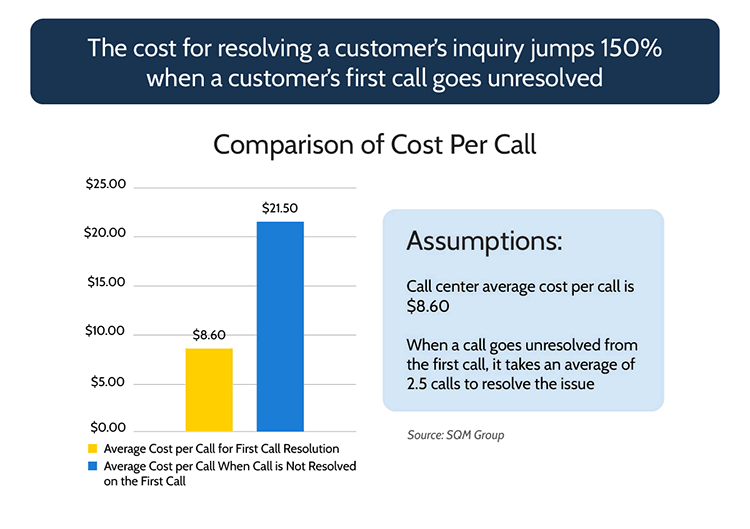
This represents an enormous cost-saving opportunity to use helpdesk agents to assist frontline agents in resolving customers' calls, preferably on the first call. In addition, an effective helpdesk system can avoid many of the additional calls the call center receives from customers whose issues are not resolved on the first call. Helpdesk agents can help improve FCR and Customer Satisfaction (Csat), reduce costs, customer dissatisfaction, and customer defections.
The Importance of Helpdesk Agents
The helpdesk support queue plays a vital role in helping customer service agents and customers resolve calls. For many organizations, the call center helpdesk agents are the last line of defense for handling customer complaints and reducing customer churn. SQM's research clearly shows that if helpdesk calls are managed effectively, Csat does not drop. However, there is a 15% drop in Csat for each additional call required to resolve the customer's call on average. Furthermore, the average call center FCR is 19% lower when the call is transferred to a helpdesk agent.
95% of customers expressed intent to continue doing business with an organization when FCR is achieved. Many enlightened leaders believe that the call center's primary purpose is to retain customers by providing FCR. Call center leaders should measure and track their contribution to customer retention.
Figure 2 shows FCR impact on customer retention. The data shows only 5% of customers expressed their desire to stop doing business with an organization when First Call Resolution is achieved. However, when it took two or more calls to resolve an inquiry or problem, 9% of customers expressed their intent to defect. Also, 13% of calls are unresolved, and in most cases, call center employees do not know which customers call goes unresolved. What is alarming about that is when a customer's issue was unresolved, 25% of those customers said they intend not to continue using the organization's products and services.
What is essential to understand is customer defections are more than five times higher for unresolved calls than when FCR is Achieved. In addition, it is a well-accepted fact that it costs organizations at least five times more to attract a new customer than to retain an existing one. Therefore, the value of retaining existing customers over acquiring a new one can't be overstated. The most significant benefit for using helpdesk agents, by far, is retaining customers, which is seldom understood or measured.
Figure 2: FCR Impact on Customer Retention
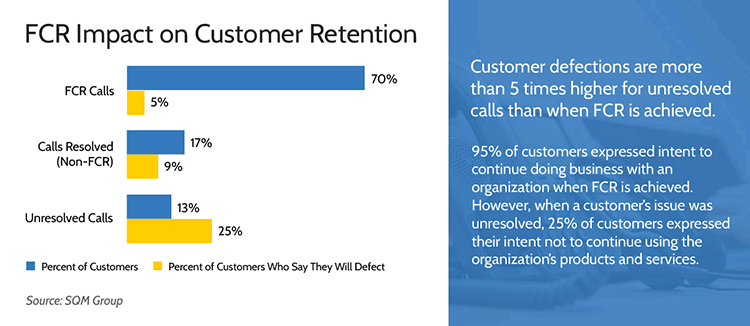
Helpdesk Support - Structure
For most call centers, customer calls that helpdesk agents handle are from the frontline agent asking for assistance versus the customer calls being transferred to them. Therefore, in many cases, the helpdesk queue has two tiers of helpdesk agents (see figure 3):
Tier 1 helpdesk agents assist frontline customer service agents with resolving their customer calls and are not in direct contact with the customer. In other words, they act as an internal helpdesk for frontline agents.
Tier 2 helpdesk agents handle complex or escalated calls by having the frontline agents transfer the call to them for resolving the customer's call directly.
Figure 3: Helpdesk Agent Queue Structure
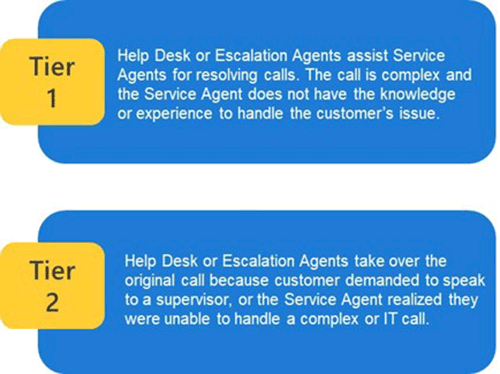
Helpdesk Best Practices

Listed are best practices for handling helpdesk calls which should be used for improving overall FCR, Esat, Csat, and customer retention performance and reducing costs:
-
The customer's problem should be attempted to be resolved by the frontline agent (e.g., the agent who first hears the call owns the call)
-
Train Helpdesk agents on how to handle angry customers, upset customers, call escalation, and complaint handling
-
The helpdesk agent should view the call as a gift and a service recovery opportunity
-
In most cases, the customer should only have to explain their problem once (e.g., warm transfer)
-
If appropriate, the customer is warm transferred to the helpdesk agent
-
If the customer is frustrated, angry, or irrational, the original agent should explain the situation to the helpdesk agent while the customer is on a mute hold and then transfer the customer to the helpdesk agent
-
Agents are encouraged to transfer calls to the helpdesk queue for resolution or to call helpdesk agents for assistance
-
Helpdesk agent takes ownership for resolving the customer problem if the call is transferred to them
-
The frontline agent keeps ownership of call resolution for helpdesk agent-assisted calls
-
Helpdesk agents are skilled (e.g., have soft skills and are knowledgeable) at handling customer complaints
-
There are 2 tiers of helpdesk agents:
- Tier 1 agents assist customer service agent in resolving call
-
Tier 2 agents takeover the call from the customer service agent to resolve the call
-
Frontline customer service agent to helpdesk agent support ratio should be 15:1
-
Helpdesk agents are located in a centralized work area
-
Helpdesk agents are available in real-time and are dedicated to supporting frontline agents
-
If cost is an issue, create a helpdesk queue by key LoBs or outsourcers, repeat callers or new customers, certain call types, or high-value customers
-
The fulfillment department has a reporting relationship with the call center
-
There is an efficient and effective knowledge management tool for assisting helpdesk agents in resolving calls
-
Helpdesk agents treat customer service agents as internal customers and are held accountable for ensuring that their internal customers are very satisfied with the support they receive for assisting them in resolving calls
Helpdesk Best Practice Example
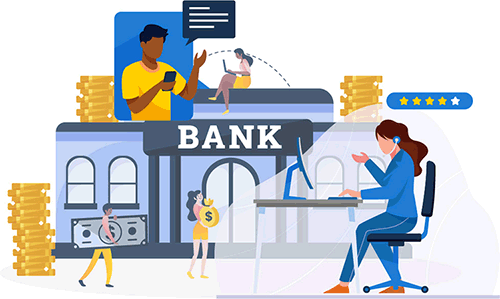
A best practice SQM has seen concerning a helpdesk is from a retail bank's call center. The bank's helpdesk team is based on a 13:1 ratio. It is staffed through workforce management to maintain the 13:1 ratio even in the middle of the night. At each site, the helpdesk team (using wireless headsets) sits in a group in the middle of the call center floor and can go to the agent if needed physically.
What is even more impressive is the absence of fear from recrimination by the agents who use the helpdesk queue. They know that the helpdesk team has the same primary goal and accountability: to resolve the customer's issue. This organization sees only a 5% FCR difference in helpdesk calls versus regular calls; whereas, the call center industry average FCR difference in helpdesk calls versus regular calls is 19%.
Helpdesk Metrics
Very few call centers measure the helpdesk queue performance from a customer's point of view, using escalation metrics calls resolved or FCR. Again, call centers use only traditional operational metrics (e.g., AHT, speed of answer, abandon, call types, and call volume) for measuring their helpdesk queue performance. Listed are metrics SQM considers best practices for measuring call center helpdesk performance:
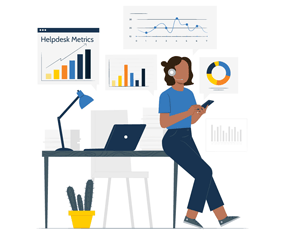
-
% of calls resolved in 1 call (FCR)
-
% of customers very satisfied with call center
-
% of customers very satisfied with helpdesk agent
-
% of customers whose call was resolved
-
% of calls transferred to helpdesk agents
-
% of calls that tier 1 agents assisted frontline agents
-
% of calls that tier 2 agents took over calls from frontline agents
-
% of calls abandoned
-
Average days to resolve helpdesk calls
-
Average handle time
-
The average speed of answer
-
The number and percent of customer complaint calls
-
Call types helpdesk handled
-
Helpdesk queue impact on customer retention
-
Frontline agent satisfaction with helpdesk agent support
-
Call volume for helpdesk queue
-
The average number of times frontline agents contact the helpdesk agents
-
Number of times each frontline agent calls the helpdesk
Quick Related Links
First Call Resolution Definition First Call Resolution PPT First Call Resolution Benefits Agent Coaching First Call Resolution Call Handling First Call Resolution Tips VoC Performance Management Agent Recognition CQA Form
